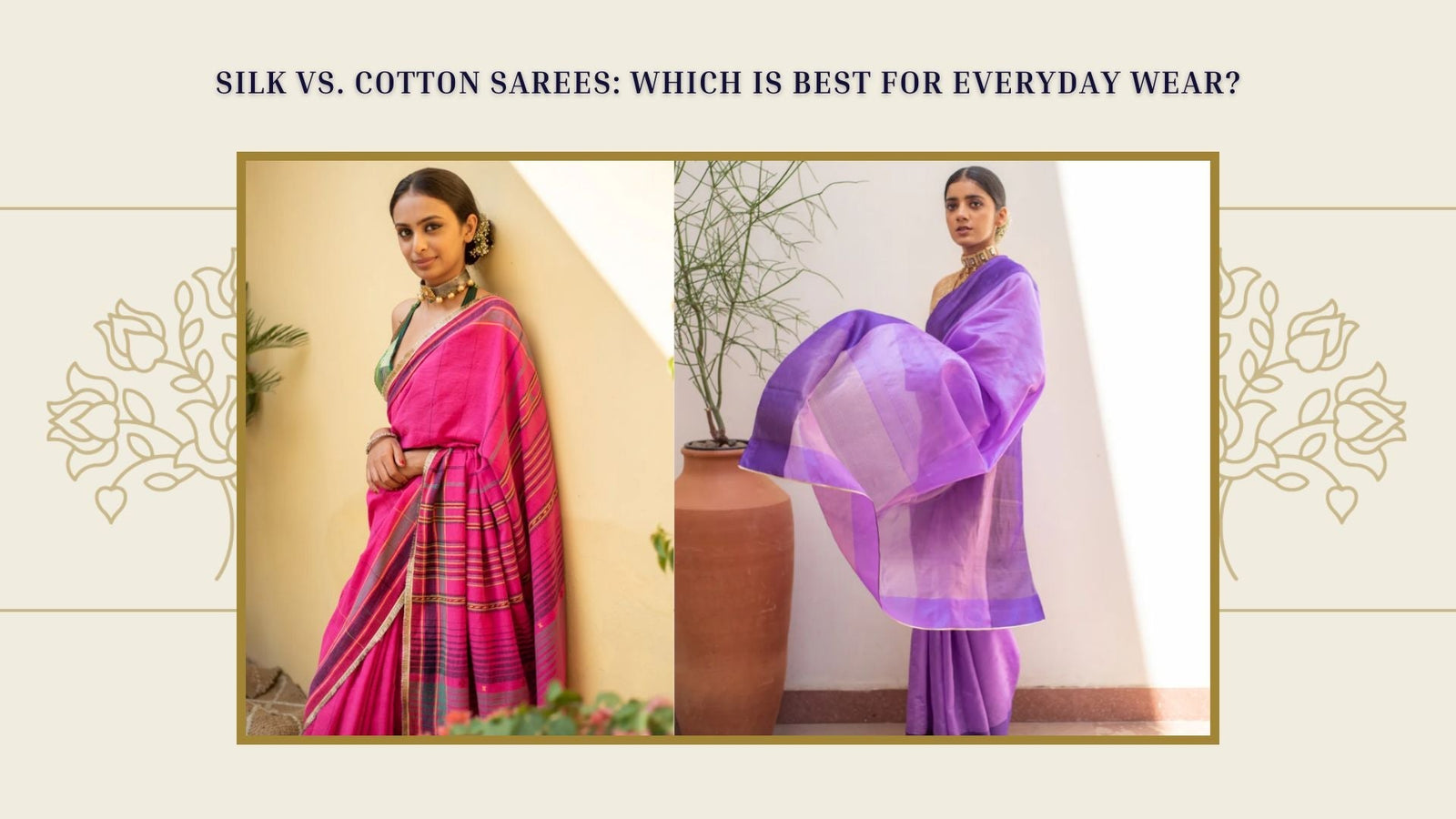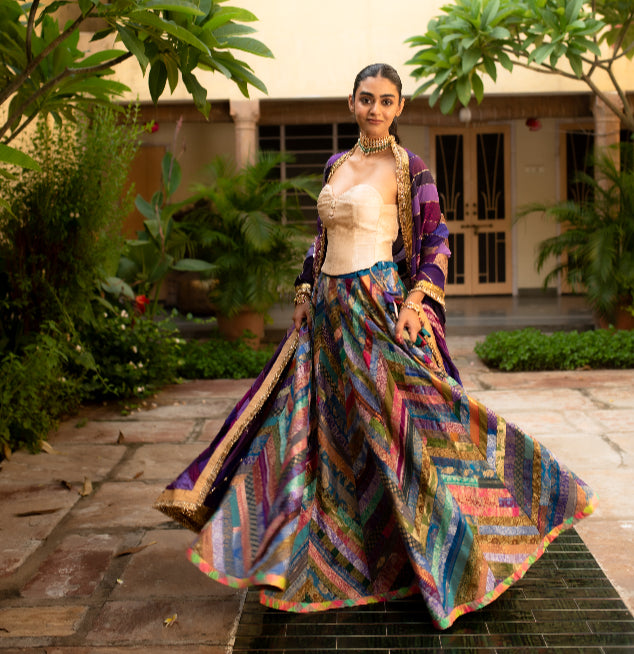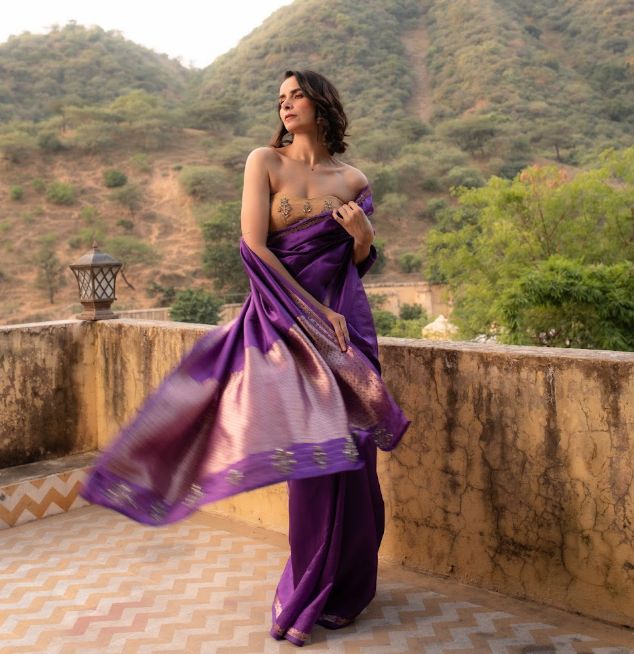Silk vs. Cotton Sarees: Which Is Best for Everyday Wear?

Introduction to Silk vs. Cotton Sarees: Which Is Best for Everyday Wear
The saree—a six-yard story that whispers secrets of heritage, elegance, and identity. It is not merely fabric; it is poetry woven into threads. When choosing a saree or everyday wear, the burning question is: which saree is your go to for women day in and day out: silk or cotton? Exploring both the fabric school, let’s delve further more into each narrative, steeped in history, emotion, and craft, unfolds as a celebration of two icons that define India’s sartorial soul.
Understanding the Unique Characteristics of Silk and Cotton Sarees

Often adorned with intricate zari work and elaborate designs, silk sarees narrate tales of skilled craftsmanship passed down through generations. They remain timeless and are predominantly reserved for occasions that demand grandeur, such as weddings, festivals, and formal events. The richness of a women's silk saree collection is known to elevate gatherings, bestowing an aura of sophistication upon the wearer.
Conversely, cotton sarees for women online embody simplicity and practicality. Lightweight and breathable, they are perfectly suited for everyday wear, combining comfort with understated elegance. The versatility of cotton sarees allows them to complement various climates and occasions, making them a staple in Indian households.
From the bustling streets of Kolkata to the serene villages of Tamil Nadu, cotton sarees have long been a choice for women who seek functionality without compromising on grace.
Silk Sarees: The Pros and Cons for Everyday Wear

Pros of Silk Sarees:
1. Luxurious Appearance: The natural sheen and smooth texture of silk add opulence, making it suitable for formal or festive settings. The intricate motifs, zari borders, and vibrant colors represent artistry at its finest.
2. Durability: With proper care, silk sarees can last decades, often becoming cherished family heirlooms. Their beauty and value endure, transcending generations.
3. Seasonal Adaptability: Silk provides warmth, offering comfort during cooler months. It is especially popular during winter weddings or festive celebrations.
Cons of Silk Sarees:
1. High Maintenance: Preservation requires meticulous care, such as storage in muslin or specialized bags and professional cleaning to maintain their luster. Silk is prone to damage from moisture and sunlight.
2. Costly Investment: The high price point of authentic silk sarees, such as Banarasi or Kanchipuram, renders them less feasible for regular use.
3. Weight: Heavily embellished silk sarees can feel cumbersome for daily activities, as the intricate zari work contributes to their weight.
Cotton Sarees: The Pros and Cons for Everyday Wear

Pros of Cotton Sarees:
1. Breathability: Cotton sarees are ideal for warm and humid climates, providing comfort through natural air circulation. They excel during the summer months.
2. Ease of Care: Unlike silk, cotton sarees are easier to maintain and can often be hand-washed or machine-washed, depending on the weave.
3. Affordability: Generally more budget-friendly, cotton sarees cater to a wide audience without compromising elegance. Handloom varieties and simple prints ensure a style for every budget.
Cons of Cotton Sarees:
1. Wrinkling: Cotton fabric is prone to creases, necessitating frequent ironing to maintain a polished appearance.
2. Limited Longevity: Repeated washing can result in fading or wear, particularly in handloom varieties. Proper care, however, extends their lifespan.
3. Seasonal Use: Cotton’s lightweight nature may not suffice for colder climates, limiting its versatility during winter.
Comparing Silk and Cotton Sarees: Key Factors to Consider

When selecting between silk and cotton sarees for daily wear, these factors should guide the decision:
1. Comfort: Cotton sarees, being lightweight, suit prolonged wear, whereas silk proves advantageous for shorter events or cooler days.
2. Occasion: Silk conveys sophistication for formal gatherings, while cotton adapts effortlessly to casual or semi-formal settings.
3. Maintenance: Cotton is low-maintenance, but silk demands professional cleaning and careful storage.
4. Budget: Cotton sarees are more economical, whereas silk sarees represent an investment. Their affordability makes cotton a practical daily choice.
Ultimately, lifestyle, routine, and personal preferences dictate the choice. While silk sarees radiate timeless grandeur, cotton sarees offer practical elegance for everyday life.
Cultural and Regional Preferences for Silk and Cotton Sarees

India’s regions exhibit distinct preferences for silk and cotton sarees. In South India, silk sarees like Kanchipuram symbolize auspiciousness and grandeur, often favoured for weddings and religious ceremonies.
These lustrous drapes are cherished as a bride’s prized possession, embodying heritage and tradition.
Meanwhile, cotton sarees dominate everyday attire in regions like West Bengal, where Tangail and Jamdani weaves are highly regarded. These sarees ensure comfort during humid summers and reflect practicality for daily chores.
Similarly, Maharashtra’s Narayanpet cotton sarees and Kerala’s Kasavu sarees are celebrated for their simplicity and cultural resonance.
Each saree, whether silk or cotton, intertwines with regional traditions, craftsmanship, and climate, embodying India’s cultural diversity. The choice often transcends personal preference, resonating with cultural identity and pride.
Tips for Choosing the Right Saree for Your Daily Needs
When selecting a saree for everyday wear, these tips prove helpful:
1. Weather Conditions: Cotton sarees suit summers, while silk fares better in cooler seasons. Lightweight silk blends or cotton-silk hybrids can offer seasonal adaptability.
2. Daily Routine: Active lifestyles benefit from the ease of movement provided by cotton sarees, while simple silk sarees enhance appearances during occasional meetings or gatherings.
3. Budget: For affordable elegance, cotton sarees present an excellent option. Reserve silk sarees for special occasions to preserve their charm.
4. Care Requirements: Time and effort invested in maintenance influence the choice. Pre-treated cotton or wrinkle-free options offer additional convenience.
Embracing the Versatility of Sarees in Modern Wardrobes

The designer saree for women remains a timeless expression of elegance and versatility. While silk sarees often serve as luxury statements, cotton sarees integrate seamlessly into dynamic lifestyles.
Designers are innovating lightweight silk and cotton-silk blends, merging tradition with contemporary needs to simplify daily wear.
From boardroom meetings to casual outings, sarees are experiencing a renaissance. Styled with innovative drapes, trendy blouses, or modern accessories, silk and cotton sarees are being reimagined for the 21st century.
This adaptability highlights their transcendence beyond trends, offering endless possibilities for self-expression.
Silk or Cotton: The Everyday Drape

Silk and cotton sarees possess unique charms, balancing beauty and functionality. Silk sarees exude grandeur, while cotton sarees offer unmatched comfort. The harmony of both styles enriches wardrobes, making them complementary rather than exclusive.
For elegant impressions on special days, silk sarees remain unparalleled. For everyday life’s hustle and bustle, cotton sarees provide comfort and breathability. Together, they celebrate the artistry of Indian heritage for you, reflecting the rhythm of your life.
Whether draped in silk or cotton, the saree transcends as an expression of identity, culture, and timeless grace. Priyanka Raajiv invites you to celebrate India and you, one saree at a time.

